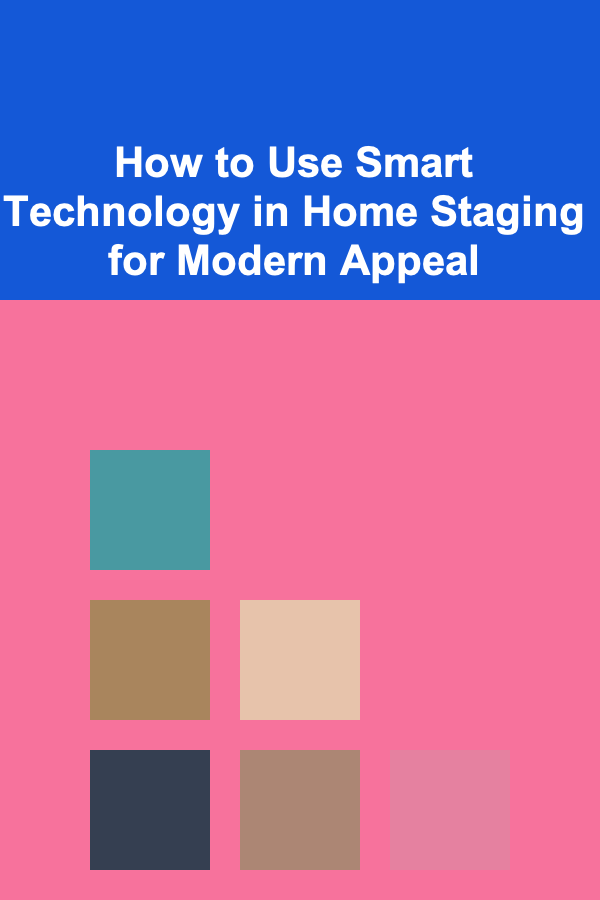
How to Use Smart Technology in Home Staging for Modern Appeal
ebook include PDF & Audio bundle (Micro Guide)
$12.99$8.99
Limited Time Offer! Order within the next:

In the world of real estate, staging a home has long been a key strategy to attract potential buyers and increase the likelihood of a fast sale. Home staging is about making a property visually appealing and functional, allowing buyers to envision themselves living in the space. However, in today's tech-savvy world, traditional staging methods are evolving to include the use of smart technology, giving homes a modern edge that appeals to tech-conscious buyers.
Incorporating smart technology into home staging doesn't just mean adding gadgets to the home. It involves thoughtfully integrating technology to enhance the functionality, comfort, and appeal of the space while also showcasing the home's potential. Smart homes are becoming increasingly popular, with devices that can control everything from lighting and temperature to security and entertainment. When used correctly, smart technology can significantly increase a home's perceived value, while also providing a glimpse into the future of living.
This article will explore how to use smart technology in home staging to create a modern, attractive home environment that appeals to today's buyers. We will discuss how to strategically incorporate smart devices into different areas of the home, the benefits of doing so, and how to make sure these technologies enhance rather than detract from the overall staging process.
Why Smart Technology in Home Staging Matters
As technology continues to play a central role in daily life, more and more buyers are looking for homes that offer convenience, efficiency, and security through smart devices. The integration of smart technology in home staging has several key benefits, including:
1. Enhanced Buyer Experience
When potential buyers tour a home, their experience is paramount. Smart technology can elevate the buyer's experience by demonstrating how a home can make life easier, more comfortable, and more enjoyable. For example, a smart thermostat that adjusts the temperature based on occupancy and time of day can show buyers how they can save on energy costs while maintaining comfort.
2. Showcasing a Modern Lifestyle
Smart home features appeal to younger buyers, especially millennials and Gen Z, who are accustomed to integrating technology into their everyday lives. A home that offers modern, connected living is more likely to resonate with these buyers. By staging a home with smart technology, sellers can demonstrate the home's potential for a tech-forward lifestyle.
3. Increased Perceived Value
Homes that feature smart technology can often command higher asking prices. Buyers are willing to pay more for properties that come with advanced home automation systems, which are often seen as a premium feature. A smart home equipped with devices like smart lighting, security cameras, and smart speakers can make a home feel more luxurious and desirable.
4. Attracting Tech-Savvy Buyers
As technology becomes more ingrained in our daily lives, tech-savvy buyers are looking for homes that already have smart devices in place. By staging a home with smart technology, sellers can attract buyers who value convenience and modern living. These buyers are more likely to recognize the value of smart devices and appreciate the home's high-tech features.
Choosing the Right Smart Technology for Home Staging
Not all smart devices are appropriate for home staging. The key is to choose devices that enhance the home's appeal without overwhelming the space. When incorporating smart technology into home staging, it's important to focus on functionality, convenience, and aesthetics. Here are some smart technologies that work well in home staging:
1. Smart Lighting
Lighting is one of the most important aspects of home staging. Proper lighting can make a space feel larger, warmer, and more inviting. Smart lighting takes this concept a step further by offering customizable options that can enhance the atmosphere of each room.
- Benefits: Smart lighting systems can be programmed to change brightness and color, allowing you to set the perfect mood for a showing. For example, you could set the lights to a soft, warm tone for evening showings or use bright, cool tones to make a room feel fresh and airy during the day.
- Best Devices: Smart bulbs and smart light switches (such as Philips Hue or LIFX) are easy to install and allow for remote control via smartphone apps or voice commands. These devices can be set to activate at specific times or triggered by motion, adding a layer of convenience that buyers will appreciate.
2. Smart Thermostats
A comfortable temperature can make a big difference in how a buyer perceives a home. A smart thermostat is an excellent way to demonstrate that the home is energy-efficient, easy to maintain, and comfortable.
- Benefits: Smart thermostats like Nest or Ecobee learn the home's temperature preferences over time and adjust automatically, ensuring that the home is always at the perfect temperature when a potential buyer walks through the door.
- Best Devices: The Nest Learning Thermostat or the Ecobee SmartThermostat are ideal for home staging, as they can be easily programmed to adjust the temperature during showings, ensuring that the home feels welcoming and comfortable when buyers arrive.
3. Smart Security Systems
Security is a top priority for many homebuyers, and showcasing a home's security features can significantly enhance its appeal. Smart security systems are an excellent way to demonstrate how a home can be kept safe and secure with minimal effort.
- Benefits: With smart security cameras, doorbell cameras, and motion detectors, buyers can easily see how these devices integrate into everyday life, offering peace of mind while enhancing convenience. For example, a smart doorbell camera (like Ring or Nest Hello) can allow homeowners to monitor visitors from their smartphones.
- Best Devices: Smart security systems such as SimpliSafe, Ring, and Arlo offer cameras, motion detectors, and doorbell cameras that can be installed easily and showcase the home's safety features without being intrusive.
4. Smart Speakers and Entertainment Systems
Today's buyers expect homes to have integrated entertainment systems that are easy to control and offer high-quality sound. Smart speakers are an excellent way to highlight a home's entertainment potential.
- Benefits: Smart speakers like Amazon Echo or Google Nest Audio offer voice-controlled music, podcasts, and home automation features. By integrating these speakers into your staging, you can create a lively atmosphere during showings by playing soft background music or even adjusting lighting and temperature with voice commands.
- Best Devices: The Amazon Echo or Google Home can be used to control other smart devices throughout the home, making them a great choice for demonstrating the benefits of home automation.
5. Smart Appliances
Smart appliances are a big selling point in the modern home. From refrigerators to ovens, smart appliances offer buyers the chance to enjoy advanced features and convenience in the kitchen.
- Benefits: Smart refrigerators can keep track of groceries, adjust temperature settings, and even suggest recipes based on available ingredients. Smart ovens can be controlled remotely, ensuring the perfect cooking experience, even when the buyer is away from home.
- Best Devices: Brands like Samsung and LG offer smart appliances with features such as touch-screen interfaces, Wi-Fi connectivity, and integration with home automation systems. Staging a kitchen with these types of appliances can demonstrate the home's modernity and appeal to buyers who value convenience and efficiency.
6. Smart Window Treatments
Smart window treatments, such as automated blinds or shades, can offer both aesthetic appeal and functionality. These devices can be set to adjust based on time of day, giving the home a sophisticated, tech-savvy look.
- Benefits: Smart blinds (like those from Lutron or Somfy) can open and close automatically based on the time of day, helping to regulate light and temperature in the home. These devices can also add an element of luxury to a home, showcasing its modern features.
- Best Devices: Lutron Serena and Somfy motorized shades are excellent choices for staging a home with a modern, high-end feel. They can be controlled remotely or set to operate on a schedule, offering a seamless, convenient living experience.
How to Integrate Smart Technology Into Your Home Staging
Integrating smart technology into home staging requires careful thought and consideration. The goal is to enhance the buyer's experience without overloading the space with gadgets. Here are some key tips for integrating smart technology into your staging process:
1. Start with the Basics
When incorporating smart devices, start with the basics: lighting, temperature, and security. These devices are practical and will help showcase the home's functionality. Smart lighting, thermostats, and security systems are easy to install and can make a big impact on a home's appeal.
2. Focus on the Key Rooms
Not every room in the house needs to be equipped with smart technology. Focus on key areas where smart devices can make the most impact, such as the living room, kitchen, and bedrooms. These are the areas where buyers will spend the most time, so it's important to showcase their potential with the right technology.
3. Ensure Seamless Integration
Smart devices should seamlessly integrate with the home's design and functionality. Avoid cluttering the space with too many devices or gadgets. Instead, choose devices that blend into the background and enhance the overall staging without distracting from the home's aesthetic.
4. Highlight the Benefits
When staging with smart technology, make sure to highlight the benefits of each device. Buyers are often more focused on how technology can improve their lives, so it's important to demonstrate how the devices work and the value they offer. For example, show buyers how easy it is to adjust the temperature with a smart thermostat or how they can monitor the security of the home remotely using a smartphone app.
5. Ensure Proper Functionality
Before showcasing a home with smart devices, make sure that everything is working properly. There's nothing worse than having a smart device malfunction during a showing, as it can create a negative impression of the home. Ensure that all devices are connected, functioning correctly, and easy to use.
Conclusion
Smart technology is transforming the way homes are staged and sold. By integrating devices that offer convenience, comfort, and security, home sellers can create an environment that resonates with today's tech-savvy buyers. From smart lighting and thermostats to security systems and entertainment options, the right technology can enhance a home's appeal and increase its perceived value.
When staging a home with smart technology, it's important to choose devices that complement the home's design, functionality, and target buyer demographic. By highlighting the benefits of each device and ensuring that everything is seamlessly integrated, sellers can create an inviting, modern home that will stand out in today's competitive real estate market.
Reading More From Our Other Websites
- [Organization Tip 101] How to Use Clear Containers for Small DIY Parts
- [Organization Tip 101] How to Use Folding Tables for Flexible Garage Space
- [Personal Care Tips 101] How to Know When It's Time to Switch Your Facial Cleanser for Better Skin Health
- [Toy Making Tip 101] Best Ways to Repurpose Recycled Plastic Bottles into Fun Building Block Sets
- [Home Space Saving 101] How to Optimize Your Laundry Room for Space Efficiency
- [Home Storage Solution 101] How to Organize Your Closet for Easy Access to Everyday Items
- [Sewing Tip 101] Hidden Zippers Made Easy: Seamless Finishing Techniques
- [Home Budget Decorating 101] How to Redesign Your Home Using Only Affordable Fabrics
- [Personal Investment 101] How to Avoid Common Investment Mistakes That Can Hurt Your Wealth
- [Home Security 101] How to Secure Your Home Against Seasonal Threats like Storms and Flooding

How to Develop an Emergency Plan for Rental Properties
Read More
How to Sell Vintage Toys on eBay: A Comprehensive Actionable Guide
Read More
How to Set Up a Family Science Fair at Home
Read More
10 Tips for a Product Launch with Influencer Marketing
Read More
10 Time Management Techniques for Your Entrepreneurial To-Do List
Read More
10 Tips for Using Your Author Planner to Combat Writer's Block
Read MoreOther Products

How to Develop an Emergency Plan for Rental Properties
Read More
How to Sell Vintage Toys on eBay: A Comprehensive Actionable Guide
Read More
How to Set Up a Family Science Fair at Home
Read More
10 Tips for a Product Launch with Influencer Marketing
Read More
10 Time Management Techniques for Your Entrepreneurial To-Do List
Read More